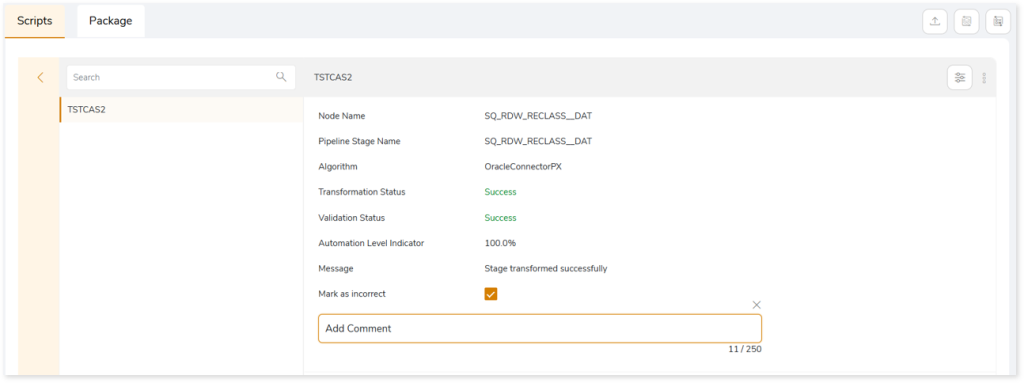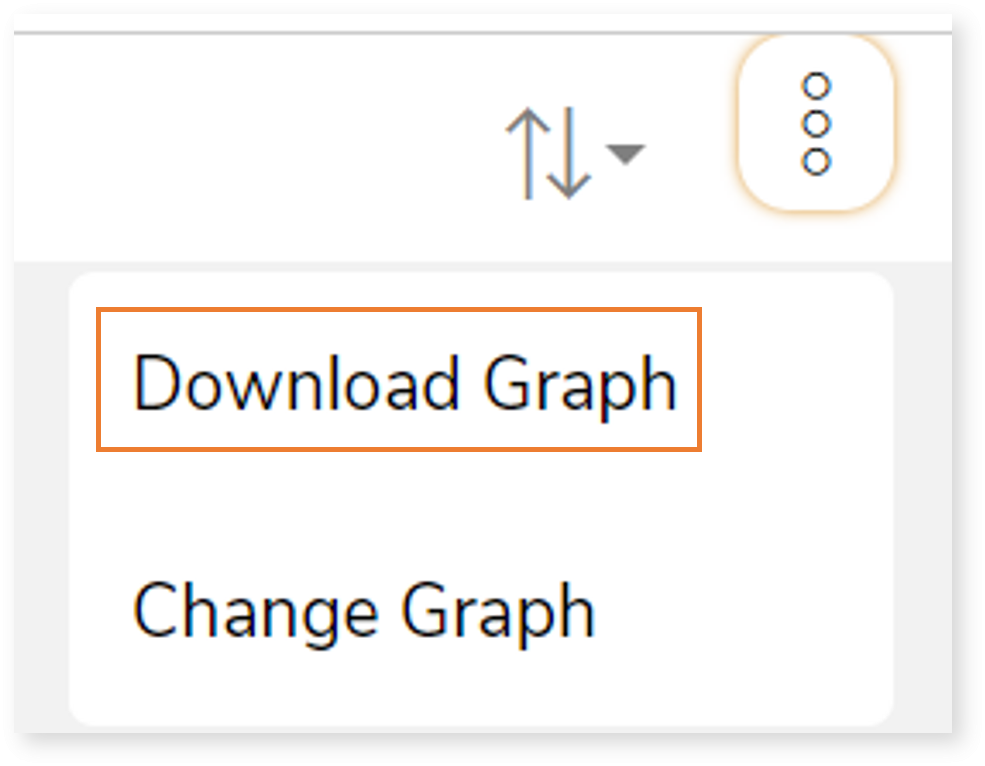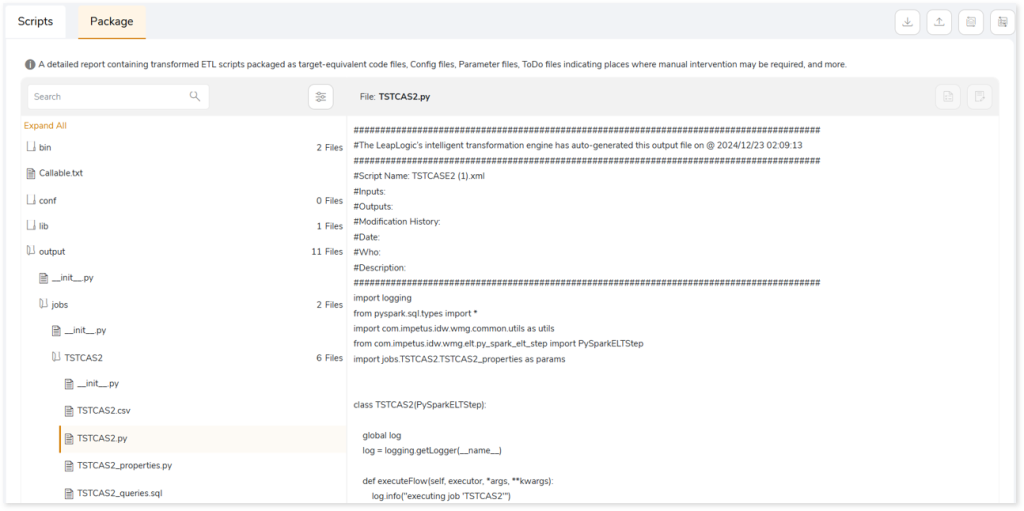DataStage Conversion Report
This topic provides a comprehensive report on DataStage ETL conversion. The ETL conversion pipeline converts legacy DataStage workloads to modern cloud platforms.

This section provides an overview of the ETL conversion, which includes:
- Scripts Transformed: Displays the number of scripts and jobs that are successful or fail to convert.
- Status: Status of the ETL conversion stage.
- Automation Level Indicator: Displays the automation conversion coverage.
- Auto-Validation (Query): Displays the percentage of queries that have undergone syntax validation successfully.
- User Feedback: Displays the automatic conversion percentage based on your feedback.
In This Topic:
Scripts
This topic shows a comprehensive report of the converted artifacts. It includes the name of the graph, number of jobs, and file-wise transformation percentage.

Browse through each script to get more insights into the nodes. In each node, you can review the transformed data and provide feedback. If you perceive that a successfully converted stage is inaccurate, then you can mark it as incorrect.

You can click Mark as Incorrect to indicate that the converted stage is incorrect. Additionally, you can provide detailed comments in the Add Comment field to explain the specific issues or discrepancies you have observed. After providing your constructive feedback, click  to recalculate the conversion automation based on your feedback. This ensures that the converted stage aligns more closely with the intended requirements or desired outcomes.
to recalculate the conversion automation based on your feedback. This ensures that the converted stage aligns more closely with the intended requirements or desired outcomes.

After clicking  (Recalculate), you can see the updated conversion automation (User Feedback) based on your feedback in the Summary section.
(Recalculate), you can see the updated conversion automation (User Feedback) based on your feedback in the Summary section.

This section also allows you to take a variety of actions, such as:
|
Feature |
Icon |
Description |
|
Download All |
 |
To download all the graphs.
You can download graphs in an alternative way by:
- Click
 on the preferred graph or node. on the preferred graph or node.
- Click
 and then select Download Graph. and then select Download Graph.

|
|
Upload |
 |
To upload a modified graph after making the required changes.
You can upload graphs in an alternative way by:
- Click
 on the preferred graph or node. on the preferred graph or node.
- Click
 and then select Change Graph. and then select Change Graph.

|
|
Regenerate |
 |
To update and repackage the uploaded or changed graph.
If the artifacts are updated successfully, the system generates a snackbar popup to notify the success.  |
|
Sort |
 |
To sort the nodes. You can sort the nodes based on:
- All Nodes
- Success Nodes
- Failed Nodes
|
Package
This topic provides a detailed report of the converted artifacts containing python files, java files, etc. LeapLogic provides target-compatible packaged code that is ready to be orchestrated and executed as production-ready jobs on target platforms such as AWS Glue, Databricks.

In the Package section, you can also see Transformation_Report.xlsx file which contains a comprehensive report of the transformation, and the associated deductible license quota. License quota is deducted for units when converting DataStage workloads to target equivalents, where unit refers to component or stage. The license deduction logic is determined based on:
- File Similarity: The platform employs a similarity evaluation framework that determines the relative correspondence of an incoming file against a corpus of previously processed artifacts. This evaluation yields a similarity index which, in turn, is reconciled with internally governed threshold parameters. The interaction between these values serves as the basis for deciding whether an adjustment to the license quota becomes applicable. In certain conditions—when the index exhibits sufficient divergence or proximity to the threshold—quota units may be appropriated, while under alternative conditions, no adjustment is applied. Accordingly, files demonstrating pronounced affinity to earlier executions may, under some circumstances, bypass incremental quota attribution, whereas those exhibiting less congruence may result in measurable deductions. The precise determination is mediated by proprietary system logic, operating on layered interpretations of similarity scores.
- Complexity: Beyond similarity considerations, the dimensional aspect of unit-level complexity exerts a significant influence on how quota utilization is ultimately reconciled. Each transformation embedded within a workflow undergoes an internalized evaluation process, wherein its relative intricacy is algorithmically weighted. The categories conventionally denoted as Simple, Medium, and Complex are best regarded as heuristic markers rather than rigid determinants, serving to indicate how the platform apportions value within the broader license framework. Quota adjustments therefore emerge not as a straightforward arithmetic application but as the aggregated outcome of weighted interpretations distributed across all constituent units. As a result, even workflows of ostensibly comparable scale may reflect markedly different quota implications, contingent upon how the system adjudicates and interprets the relative complexity of their internal transformations. In effect, the quota impact is shaped less by file size alone than by the nuanced interplay of classification, weighting, and systemic evaluation.
- Automation Level Indicator: Automation Level Indicator refers to the extent to which files are automatically converted from source to the target equivalent. Higher automation level indicator value indicates that most of the file is automatically converted and requires less manual intervention. The license quota deduction depends on whether the automation level indicator meets or exceeds the predefined threshold value.
- Number of Successfully Transformed ETL Scripts: This is one of the criteria used for license quota deduction, where the deduction depends on the number of successfully transformed ETL Scripts.
You can see the Transformation_Report.xlsx report below.

The License Summary sheet (refer the above image) in Transformation_Report.xlsx file showcases detailed information about the license deductible quota.
- File Name: Displays the name of the file.
- Job Name: Displays the name of the job.
- Job Type: Displays the type of the job such as parallel job or sequence job.
- Automation Level Indicator: Displays the auto-conversion percentage of each job.
- File Similarity: Indicates whether the file is similar to the already executed file. If the value is true, then the file is similar to an already executed file else false.
- Complexity: Displays the complexity of each script.
- Total Stages: Displays the number of total stages.
- Success Stages: Displays the number of successfully transformed stages.
- Deductible Units: Displays the unit quota that needs to be deducted based on the complexity checks and balances.
- Deducted Unit Quota: Displays the actual unit quota deducted.
The Translation_Report sheet in Transformation_Report.xlsx file provides a comprehensive report of the conversion. It includes information about jobs, stages, and the conversion status of stages. If the value of conversion status is true, then the stage is converted successfully to the target equivalent else false.

- File Name: Displays the name of the file.
- Job Name: Displays the name of the job.
- Stage Name: Displays the name of the stage.
- Stage Type: Displays the type of each stage.
- Conversion Status: Indicates the conversion status of each stage. If the value is SUCCESS the stage is converted successfully, else FAIL.
The Transformation_License_Report sheet provides a comprehensive report of the conversion along with the unit quota deduction.

- File Name: Displays the name of the file.
- Job Name: Displays the name of the job.
- Stage Name: Displays the name of the stage.
- Stage Type: Displays the type of each stage.
- Conversion Status: Indicates the conversion status of each stage. If the value is SUCCESS the stage is converted successfully, else FAIL.
- Automation Level Indicator: Displays the auto-conversion percentage of each job.
- Complexity: Displays the complexity of each stage.
- Deductible Units: Displays the unit quota that needs to be deducted based on the complexity checks and balances.
- Deducted Unit Quota: Displays the actual unit quota deducted.
When you try to convert units that exceed the available license quota, those within the quota will successfully convert. However, any additional units beyond the quota will fail to transform and display an error message indicating ‘License quota exhausted.’

While configuring the DataStage to Databricks Lakehouse conversion stage, if the selected output type is DBT, then you will get dbt_packages, models, TODO files, workflows, etc., in the transformed artifacts report. In the models folder, you can find SQL files containing transformed codes that can be run directly on the DBT platform. The required queries in the output files can be edited through an online notebook-based code editor and can be repackaged.